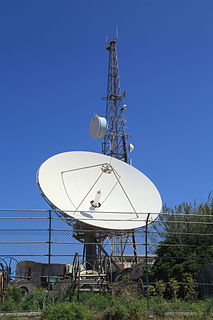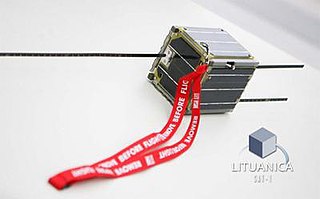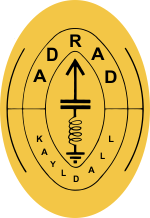
This article is an overview of telecommunications in Malta.

In digital radio, packet radio is the application of packet switching techniques to digital radio communications. Packet radio uses a packet switching protocol as opposed to circuit switching or message switching protocols to transmit digital data via a radio communication link. Packet radio can be differentiated from other digital radio switching schemes by the following attributes:
The American Radio Relay League (ARRL) is the largest membership association of amateur radio enthusiasts in the United States. ARRL is a non-profit organization, and was co-founded on April 6, 1914, by Hiram Percy Maxim and Clarence D. Tuska of Hartford, Connecticut. The ARRL represents the interests of amateur radio operators before federal regulatory bodies, provides technical advice and assistance to amateur radio enthusiasts, supports a number of educational programs and sponsors emergency communications service throughout the country. The ARRL has approximately 161,000 members. In addition to members in the US, the organization claims over 7,000 members in other countries. The ARRL publishes many books and a monthly membership journal called QST.

PMR446 is a licence exempt service in the UHF radio frequency band and is available for business and personal use in most countries throughout the European Union.
The 33-centimeter or 900 MHz band is a portion of the UHF radio spectrum internationally allocated to amateur radio on a secondary basis. It ranges from 902 to 928 MHz and is unique to ITU Region 2. It is primarily used for very local communications as opposed to bands lower in frequency. However, very high antennas with high gain have shown 33 centimeters can provide good long-range communications almost equal to systems on lower frequencies such as the 70 centimeter band. The band is also used by industrial, scientific, and medical (ISM) equipment, as well as low-powered unlicensed devices. Amateur stations must accept harmful interference caused by ISM users but may receive protection from unlicensed devices.
CQ is a code used by wireless operators, particularly those communicating in Morse code,, but also by voice operators, to make a general call. Transmitting the letters CQ on a particular radio frequency is an invitation for any operators listening on that frequency to respond. It is still widely used in amateur radio.

Contesting is a competitive activity pursued by amateur radio operators. In a contest, an amateur radio station, which may be operated by an individual or a team, seeks to contact as many other amateur radio stations as possible in a given period of time and exchange information. Rules for each competition define the amateur radio bands, the mode of communication that may be used, and the kind of information that must be exchanged. The contacts made during the contest contribute to a score by which stations are ranked. Contest sponsors publish the results in magazines and on web sites.
Amateur radio frequency allocation is done by national telecommunication authorities. Globally, the International Telecommunication Union (ITU) oversees how much radio spectrum is set aside for amateur radio transmissions. Individual amateur stations are free to use any frequency within authorized frequency ranges; authorized bands may vary by the class of the station license.

An amateur radio station is a radio station designed to provide radiocommunications in the amateur radio service for an amateur radio operator. Radio amateurs build and operate several types of amateur radio stations, including fixed ground stations, mobile stations, space stations, and temporary field stations. A slang term often used for an amateur station's location is the shack, named after the small enclosures added to the upperworks of naval ships to hold early radio equipment and batteries.

An amateur radio repeater is an electronic device that receives a weak or low-level amateur radio signal and retransmits it at a higher level or higher power, so that the signal can cover longer distances without degradation. Many repeaters are located on hilltops or on tall buildings as the higher location increases their coverage area, sometimes referred to as the radio horizon, or "footprint". Amateur radio repeaters are similar in concept to those used by public safety entities, businesses, government, military, and more. Amateur radio repeaters may even use commercially packaged repeater systems that have been adjusted to operate within amateur radio frequency bands, but more often amateur repeaters are assembled from receivers, transmitters, controllers, power supplies, antennas, and other components, from various sources.
D-STAR is a digital voice and data protocol specification for amateur radio. The system was developed in the late 1990s by the Japan Amateur Radio League and uses minimum-shift keying in its packet-based standard. There are other digital modes that have been adapted for use by amateurs, but D-STAR was the first that was designed specifically for amateur radio.
An international distress frequency is a radio frequency that is designated for emergency communication by international agreement.
An amateur radio propagation beacon is a radio beacon, whose purpose is the investigation of the propagation of radio signals. Most radio propagation beacons use amateur radio frequencies. They can be found on LF, MF, HF, VHF, UHF, and microwave frequencies. Microwave beacons are also used as signal sources to test and calibrate antennas and receivers.
The Radio Club Peruano (RCP) is a national non-profit organization for amateur radio enthusiasts in Peru. RCP was founded on December 6, 1930, and the first General Meeting of the organization was held in the halls of the Library of the Geographical Society in Lima, Peru in January, 1931. The RCP operates a QSL bureau for those amateur radio operators in regular contact with amateur radio operators in other countries, and supports amateur radio operating awards and radio contests. Radio Club Peruano represents the interests of Peruvian amateur radio operators before national and international regulatory authorities. RCP is the national member society representing Peru in the International Amateur Radio Union.

Amateur radio, also known as ham radio, is the use of the radio frequency spectrum for purposes of non-commercial exchange of messages, wireless experimentation, self-training, private recreation, radiosport, contesting, and emergency communications. The term "amateur" is used to specify "a duly authorised person interested in radioelectric practice with a purely personal aim and without pecuniary interest;" and to differentiate it from commercial broadcasting, public safety, or professional two-way radio services.
Digital mobile radio (DMR) is a limited open digital mobile radio standard defined in the European Telecommunications Standards Institute (ETSI) Standard TS 102 361 parts 1–4 and used in commercial products around the world. DMR, along with P25 phase II and NXDN are the main competitor technologies in achieving 6.25 kHz equivalent bandwidth using the proprietary AMBE+2 vocoder. DMR and P25 II both use two-slot TDMA in a 12.5 kHz channel, while NXDN uses discrete 6.25 kHz channels using frequency division and TETRA uses a four-slot TDMA in a 25 kHz channel.

The Associação de Radioamadores da Linha de Cascais, aka ARLC and Cascais Amateur Radio Association, was founded on 28 December 2011 to promote ham radio activity especially for youngsters, unite all amateurs, work with emergency authorities, and to support amateur radio and science investigation.

LituanicaSAT-1 was one of the first two Lithuanian satellites. It was launched along with the second Cygnus spacecraft and 28 Flock-1 CubeSats aboard an Antares 120 carrier rocket flying from Pad 0B at the Mid-Atlantic Regional Spaceport on Wallops Island to the International Space Station. The launch was scheduled to occur in December 2013, but later was rescheduled to 9 January 2014 and occurred then. The satellite was broadcasting greetings of Lithuanian president, Mrs. Dalia Grybauskaitė. The satellite was deployed from the International Space Station via the NanoRacks CubeSat Deployer on February 28, 2014. All LituanicaSAT-1 subsystems have been turned on, tested and proved to be working properly. The mission is considered a complete success by its team of engineers. The mission ended upon the reentry and disintegration of the satellite on July 28, 2014.

The Luxembourg Amateur Radio Union (LARU) is a national non-profit organization for amateur radio enthusiasts in Luxembourg . The LARU was founded on January 1, 2014. The LARU promotes technical progress and cohesion of amateur radio operators. The LARU sets priorities in emergency communications, digital voice communications, digital data transmission, science and education.
The ICOM IC-905 is a multimode VHF/UHF/SHF portable amateur radio transceiver. The radio has between 10 and 0.5 watts of transmitter output depending on the frequency selected. The radio was announced by ICOM on August 22 at the Tokyo Ham Radio Fair in Japan. The IC-905 has support for a wide variety of commonly used amateur radio modes including ICOM's proprietary digital voice mode DSTAR. The form factor of the control head for the IC-905 is similar to that of the IC-705 and includes its large screen and spectrum scope. With the radio unit being remotely controlled from a distance in order to reduce loss over long coax cable runs. This is an important adaptation for this radio system as losses increase with the frequency being used. The IC-905 uses a built in GPS receiver to stabilize its frequency and time base. It has been noted that the IC-905 has a wide range of frequencies but lacks the 220MHz and 900MHz amateur bands as these are only available in North America and not Japan. The unit supports up to four external antennas and has built in support for wired Ethernet, USB Type C and an SD card reader. The addition of a USB connector allows users to connect their computers to the IC-905 for running digital data modes such as Winlink, or FT8, the integration of Ethernet support will be a useful feature for mobile contesters.









